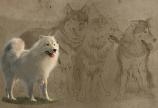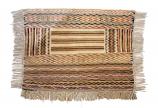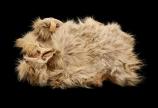DNA found for Coast Salish woolly dog
- Anne MacLaurin

“Mutton,” a very special young Indigenous wool dog, was among the last of an ancient breed domesticated and kept by Coast Salish Peoples for its highly sought-after woolly fur. In a first high-resolution DNA study of Mutton—the only known woolly dog fleece in the world—an international researcher team from the Smithsonian’s Natural Museum of Natural History and the University of Victoria, pinpointed the genes responsible for the unusually long, crimpy undercoat, which was highly spinnable and could be made into warm blanket yarn.
The study’s findings, published on Thursday in the journal Science, was led by evolutionary molecular biologist Audrey Lin, who analyzed genetic clues preserved in the pelt of Mutton.
Lin and the team analyzed more than 11,000 different genes in Mutton’s genome to determine what gave woolly dogs their fluffy fleece and wool fibers that could be spun together to create yarn and incredibly valuable blankets. They identified 28 genes that have links to hair growth and follicle regeneration. These included a gene that causes a woolly hair phenotype in humans, and another linked to curly hair in other dogs and affirmed archaeological evidence this breed is between 2,000 to 5,000 years old.

However, Mutton’s genetics could tell the researchers little about what caused the dogs to decline. Indigenous Elders, Knowledge Keepers and Master Weavers know through longstanding oral histories that for dogs like Mutton, the disappearance of this special breed was due to colonial policies of cultural genocide, displacement and forced assimilation, it likely became increasingly difficult or forbidden for Coast Salish communities to maintain the distinctiveness of their woolly dogs.
Many in the Coast Salish communities were eager to share their knowledge and participate in the study that embraced sophisticated western science with established Traditional Knowledge.
Michael Pavel, an Elder from the Skokomish/Twana Coast Salish community in Washington, who remembers hearing about woolly dogs early in his childhood, says, “it was incredibly rewarding to contribute to this effort to embrace and celebrate our understanding of the woolly dog.”
The only animal bone archaeologist on the team, co-author and UVic Anthropology professor, Iain McKechnie, says Indigenous participants contributed a huge amount of cultural knowledge to this research.
“Indigenous Knowledge Keepers shared how their ancestors raised and cared for their wool dogs and the circumstances that led to their diminished role in traditional Coast Salish practices.”
- Iain McKechnie, co-author and UVic Anthropology professor
McKechnie feels fortunate to have been meeting regularly with the team and steering committee over the past few years. His recent work on domestic dogs was integrated with the DNA analysis. For this study he measured Mutton’s bones using X-rays of bones in the paws to estimate body size and compared this to earlier work on the woolly dog bones and advised on the geochemical analysis of Mutton’s diet, building on previous research.
‘Couldn’t do their cultural things’
Survival of woolly dogs depended upon the survival of their caretakers. In addition to disease, expanding colonialism increased cultural upheaval, displacement of Indigenous Peoples, and a diminished capacity to manage the breed.
Stó:lō elder Rena Point Bolton, who was 95 years old in 2022 when interviewed, recalls how Th’etsimiya, her great-grandmother, had kept woolly dogs, but was forced to give them up: “They were told they couldn’t do their cultural things. There was the police, the Indian Agent and the priests. The dogs were not allowed. She had to get rid of the dogs.”

Weaving and woolly dogs are intertwined in Coast Salish culture and society, which cannot be separated from the long-time management of their ancestral homelands. Weavers, artists, and elders continue to promote the renewal of traditional or customary weaving knowledge and practices.
The international study was guided by a steering committee of Coast Salish weavers, Knowledge Keepers, Elders and young people who received early guidance from the Honorable Steven Point (Chancellor of University of British Columbia, former Lieutenant Governor of British Columbia and Grand Chief of the Stó꞉lō Nation) and Gwen Point (Chancellor of the University of the Fraser Valley) (a full list of the steering committee, news release https://newsdesk.si.edu).
The research reflects UVic’s commitment to ʔetal nəwəl | ÁTOL,NEUEL | Respecting the rights of one another and being in right relationship with all things.
Read the Smithsonian news release.
Photos



In this story
Keywords: Indigenous, anthropology, research, administrative, partnerships, community, international, sustainability, administrative
People: Iain McKechnie




